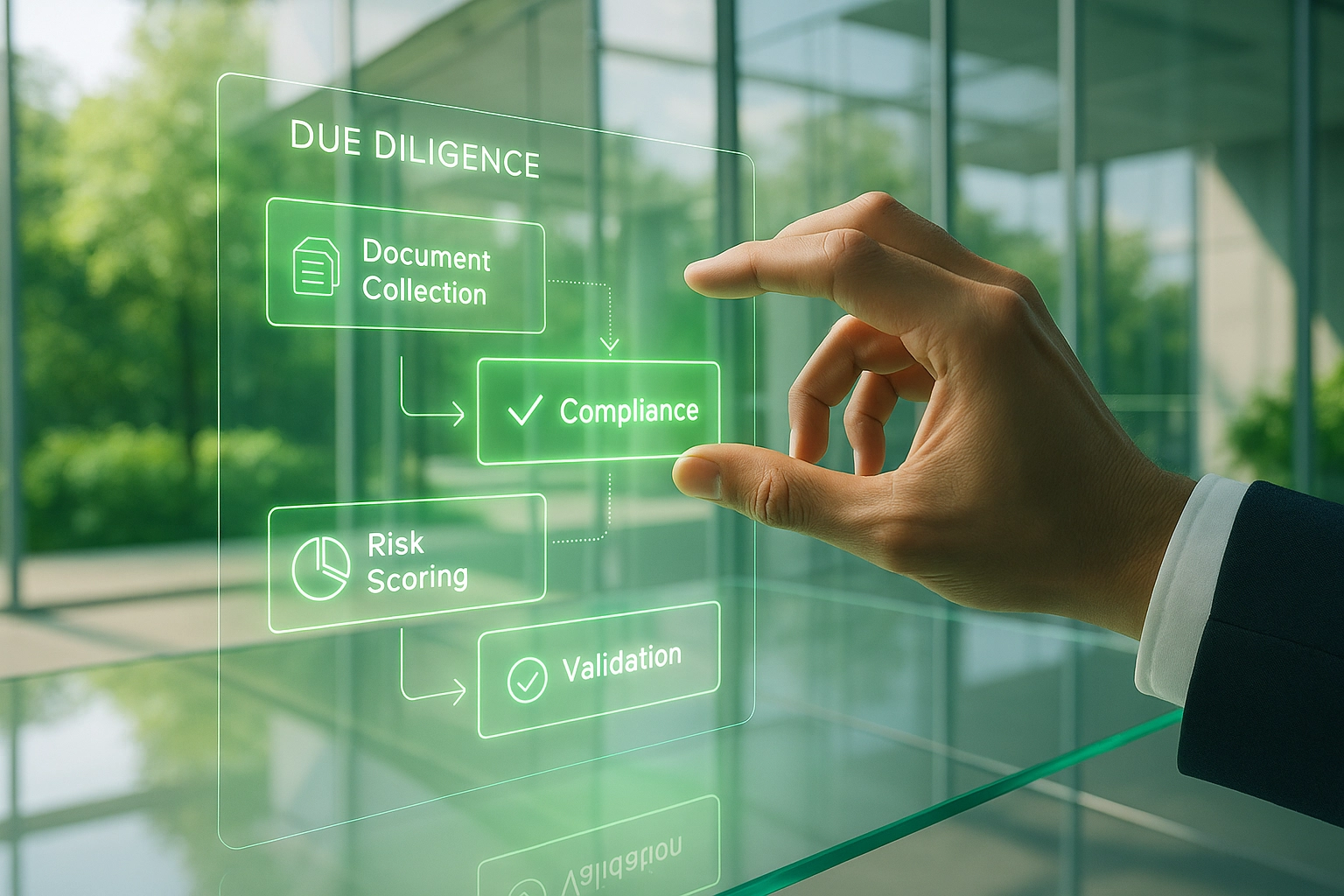Optimizing Productivity Through Automated Due Diligence

Amid increasing regulatory demands and the growing complexity of value chains, third-party governance has become a strategic imperative for European organizations. With over 430,000 third parties managed on its platform, Aprovall supports this transformation by combining regulatory expertise with technological innovation.
Automated due diligence is revolutionizing third-party evaluation by leveraging AI-powered predictive document analysis, sector-specific intelligent workflows, and real-time multi-source monitoring. This integrated approach addresses six critical compliance domains: cybersecurity, business ethics, environment, social, finance, and legal.
What Is Automated Due Diligence?
Automated due diligence transforms third-party evaluation through artificial intelligence and machine learning. This innovative approach allows companies to analyze vast volumes of data within hours—tasks that previously took weeks.
At the core of this technological shift are three key components:
- Predictive document analysis uses AI to automatically process and classify contracts, agreements, and compliance reports—cutting analysis time by up to 70% and minimizing human error.
- Sector-specific intelligent workflows adapt evaluations to industry needs. In the public sector, for example, they incorporate public procurement rules and GDPR compliance (see case study).
- Real-time multi-source monitoring ensures continuous oversight of third parties using over 60 global databases, enabling early detection of emerging risks.
Together, these tools provide a clear and precise view of transaction-related risks and opportunities.
What Productivity Gains Can Be Expected?
In today’s competitive landscape, automated due diligence is a major operational efficiency driver. Organizations aim to streamline processes while enhancing regulatory compliance.
Speed and Accuracy
The Aprovall360 platform combines AI and intelligent workflows to generate real-time, detailed reports. Automation not only accelerates processing but also improves accuracy through predictive document analysis. Multi-source monitoring ensures constant oversight via EU regulatory databases.
Cost Reduction
The mutualized pay-to-collect model disrupts traditional due diligence approaches. By automating third-party evaluations, organizations significantly reduce operating costs while benefiting from a shared knowledge base.
Assess your third-party governance maturity for free
Improving Third-Party Risk Management
Third-party governance is now a critical concern amid rising incident rates. In 2024, 62% of organizations experienced disruptions tied to supply chain cybersecurity—a 13% increase over the previous year.
Collaborative evaluation is the response to these new challenges. Our integrated approach combines:
- Predictive document analysis for proactive risk anticipation
- Real-time multi-source monitoring for early warning
- Sector-specific intelligent workflows for tailored assessments
This methodology addresses a concerning reality: 89% of organizations face unresolved third-party risk compliance issues.
More Comprehensive Risk Assessment
Predictive analytics strengthen early risk detection by processing millions of records and alerts in real time—identifying threats before they materialize.
Fraud Prevention and Cybersecurity
Cybersecurity and fraud threats are increasingly common. Automated due diligence helps identify vulnerabilities and prevent costly incidents. Systems can flag anomalies that signal potential fraudulent or malicious activity.
With 61% of companies experiencing third-party-related data breaches in 2024—a 49% increase from 2023—automated due diligence enhances anomaly detection and incident prevention.
Effective for Pay-to-Collect Models
The pay-to-collect model redefines due diligence by relying on shared data and assessments. Studies show that companies using automated due diligence solutions can process up to 80% more transactions while lowering operational costs.
Cash Flow Optimization
Automation accelerates document and payment processing. Companies can shorten invoice cycles from 14 days to just 1–2 days—avoiding costly late penalties.
Litigation Minimization
The integrated platform ensures full traceability of evaluations and reduces supplier clarification requests by up to 70%, thanks to increased transparency. Real-time visibility allows for early resolution of issues before they escalate.
Best Practices for Integration
Adopting an automated due diligence solution requires a structured approach to maximize impact. According to Gartner, 67% of organizations that succeed in digital transformation follow structured implementation methodologies.
Select the Right Tools
Tool selection should be based on three criteria: integration with existing systems, regulatory coverage by sector, and scalability. McKinsey reports that organizations prioritizing interoperability achieve 35% higher ROI on digital transformation projects.
Train Your Team
The success of a third-party governance system hinges on user adoption. A structured training plan should include:
- Remediation best practices
- Mastery of automated workflows
- Interpreting alerts and reports
The Future Impact of Automated Due Diligence
Automated due diligence is a transformative technology gaining momentum. In 2023, 80% of transactions already involved digital risk assessments.
Personalization and Intelligence
Advances in AI now allow automatic generation of up to 95% of due diligence reports, freeing human experts for strategic analysis. This shift also enables greater personalization through sector-specific intelligent workflows.
Technological Convergence
Emerging regulations like DORA and NIS 2 require multi-tech approaches. Organizations adopting these digital tools report up to 40% faster processing times and significantly improved analysis accuracy.
Learn how to automate your due diligence
Aprovall offers ready-to-use evaluation pathways validated across industries. These automated journeys streamline third-party engagement and provide high-performance scoring and reporting dashboards aligned with internal content systems—highlighting third-party engagement and ESG maturity levels.
These articles might interest you
-
 16 May 2025Why Assessing Upstream Suppliers Is EssentialSolutionsUpper-Tier Suppliers: The (Too Often) Overlooked Risk in Your Supply Chain Modern procurement chains rely on a multitude of actors, each contributing to value creation—extraction, manufacturing, assembly… The final product is never the result of a single supplier but rather the outcome of an often international ecosystem. Yet, most organizations still focus their efforts and […]
16 May 2025Why Assessing Upstream Suppliers Is EssentialSolutionsUpper-Tier Suppliers: The (Too Often) Overlooked Risk in Your Supply Chain Modern procurement chains rely on a multitude of actors, each contributing to value creation—extraction, manufacturing, assembly… The final product is never the result of a single supplier but rather the outcome of an often international ecosystem. Yet, most organizations still focus their efforts and […]Read more
-
 25 June 2025Manage Your Supplier Assessments by Context and Project for a 360° ViewSolutionsUnlock the Power of Context-Based Evaluations: Gain Clarity and Impact Supplier assessments are often structured as a top-down relationship: from the client (or buyer) to a panel of suppliers. However, these suppliers frequently operate within shared contexts — whether that’s a product, a contract, or an entire supply chain. Managing third-party evaluations by context gives […]
25 June 2025Manage Your Supplier Assessments by Context and Project for a 360° ViewSolutionsUnlock the Power of Context-Based Evaluations: Gain Clarity and Impact Supplier assessments are often structured as a top-down relationship: from the client (or buyer) to a panel of suppliers. However, these suppliers frequently operate within shared contexts — whether that’s a product, a contract, or an entire supply chain. Managing third-party evaluations by context gives […]Read more
-
 10 January 2025Supplier Cybersecurity Assessment: Key Criteria and ISO ExpertiseSolutionsIn 2024, cyberattacks have reached a critical level with a projected global cost of $9.5 trillion. The recent Change Healthcare breach, compromising the data of 190 million people, perfectly illustrates the catastrophic risks tied to the supply chain. Faced with this threat, where a new attack occurs every 11 seconds, rigorous supplier cybersecurity assessment has become a strategic pillar of third-party […]
10 January 2025Supplier Cybersecurity Assessment: Key Criteria and ISO ExpertiseSolutionsIn 2024, cyberattacks have reached a critical level with a projected global cost of $9.5 trillion. The recent Change Healthcare breach, compromising the data of 190 million people, perfectly illustrates the catastrophic risks tied to the supply chain. Faced with this threat, where a new attack occurs every 11 seconds, rigorous supplier cybersecurity assessment has become a strategic pillar of third-party […]Read more
-
 20 February 2025Automating Sapin II Compliance Controls: A Technological Solution for Regulatory ConformitySolutionsIn a constantly evolving regulatory environment, French companies face increasing challenges in complying with Sapin II law, particularly regarding anti-corruption efforts. These requirements are especially critical in strategic sectors such as the public sector, construction, industry, and retail, where partner-related risks are omnipresent. Automating compliance controls through advanced technological solutions offers an effective way to manage these complex issues. By […]
20 February 2025Automating Sapin II Compliance Controls: A Technological Solution for Regulatory ConformitySolutionsIn a constantly evolving regulatory environment, French companies face increasing challenges in complying with Sapin II law, particularly regarding anti-corruption efforts. These requirements are especially critical in strategic sectors such as the public sector, construction, industry, and retail, where partner-related risks are omnipresent. Automating compliance controls through advanced technological solutions offers an effective way to manage these complex issues. By […]Read more
